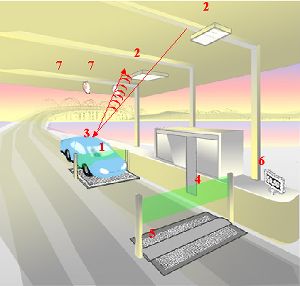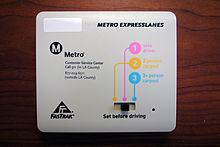FasTrak
[1] Three years later, Transportation Corridor Agencies opened the Foothill Toll Road in Orange County, implementing the statewide ETC system for the first time, and naming it FasTrak.
The state continues to delegate the responsibility of selling and maintaining FasTrak accounts to the different toll agencies.
[2] It uses RFID technology near 915 MHz to read data from a transponder placed in a vehicle (usually mounted by Velcro strips to the windshield) moving at speeds that may exceed 70 mph (112 km/h).
This would allow compatibility with systems used in nearby states of Washington, Colorado, and Utah; and also Kentucky, Indiana, Georgia, North Carolina, and Louisiana, plus NationalPass.
If one fails to correctly list license plates on their account, the FasTrak customer will receive toll violation notices as if they were another driver.
The CTOC's members include:[5] All toll facilities in the San Francisco Bay Area share the same billing, customer service center, and web site.
[6] All the other toll agencies in Southern California have separate billing, customer service centers, and web sites.
[8][20][21] For eligible clean air vehicles (CAVs) registered with the California DMV, the Bay Area FasTrak center and Riverside County HOT express lanes also offer a special "FasTrak CAV" tag for those who qualify for those discounts on applicable toll facilities.
[15][17] Other toll agencies may instead offer a special account for registered clean air vehicles on their HOT express lanes.
[28][29][30] Furthermore, FasTrak's basic functionality and specifications are listed under Title 21, Division 2, Chapter 16 of the California Code of Regulations, and are thus freely accessible to the general public.
[29] In response, the Bay Area Metropolitan Transportation Commission stated that they would contact the vendors manufacturing the FasTrak equipment and transponders to "identify potential risks and corrective actions".
[34] When TCA first introduced the FasTrak system, the electronic transponders consisted of a gadget about the size of a Walkman in which a smart card was inserted.
[35] However, the smart cards were unpopular with both tollway officials and users because they cost more, offered little advantage, and customers were charged with a $10 annual fee (which has since been discontinued).
[36] By the time the 91 Express Lanes opened in 1995, the FasTrak transponders were redesigned to be the size of a coaster that could be mounted by Velcro strips to the windshield.
However, bureaucratic inaction, technical difficulties, and financial mismanagement delayed the deployment of the system to the other six state-run toll bridges in the San Francisco Bay Area until October 2000.
[42] When the Metro ExpressLanes opened in Los Angeles in late 2012, it introduced FasTrak transponders with a special switch that indicates the number of occupants (1, 2, or 3 or more) in the vehicle.
[44] For the convenience of their FasTrak customers in the Greater Los Angeles urban area who may also use the Metro ExpressLanes, TCA began offering switchable transponders in 2013,[45] and the 91 Express Lanes followed suit by 2015.
[23] For the HOT lanes in San Diego, drivers can "declare" that they are a carpool (and thus do not have to pay a toll) by covering their FasTrak transponder in a mylar bag.
This would allow compatibility with systems used in nearby states of Washington, Colorado, and Utah; and also Kentucky, Indiana, Georgia, North Carolina, and Louisiana, plus NationalPass.





